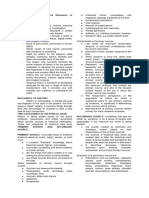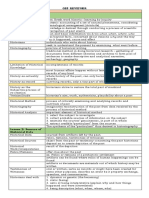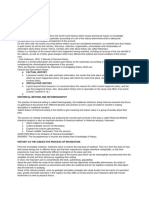0 ratings0% found this document useful (0 votes)
21 viewsSources of Historical Data
Sources of Historical Data
Uploaded by
SOPHIA BIANCA D. EHIRAHistorical data comes from artifacts and testimonies from the past. Written sources include narratives, diplomatic documents, and social documents. Narratives are chronicles or tracts presented in a variety of forms for different purposes. Diplomatic sources document legal situations and transactions. Social documents contain economic, social, and political information. Non-written sources include material evidence from artifacts and oral evidence from tales, folk songs, and interviews. Primary sources are first-hand accounts while secondary sources interpret and analyze primary sources and events.
Copyright:
© All Rights Reserved
Available Formats
Download as PDF, TXT or read online from Scribd
Sources of Historical Data
Sources of Historical Data
Uploaded by
SOPHIA BIANCA D. EHIRA0 ratings0% found this document useful (0 votes)
21 views3 pagesHistorical data comes from artifacts and testimonies from the past. Written sources include narratives, diplomatic documents, and social documents. Narratives are chronicles or tracts presented in a variety of forms for different purposes. Diplomatic sources document legal situations and transactions. Social documents contain economic, social, and political information. Non-written sources include material evidence from artifacts and oral evidence from tales, folk songs, and interviews. Primary sources are first-hand accounts while secondary sources interpret and analyze primary sources and events.
Original Title
SOURCES OF HISTORICAL DATA
Copyright
© © All Rights Reserved
Available Formats
PDF, TXT or read online from Scribd
Share this document
Did you find this document useful?
Is this content inappropriate?
Historical data comes from artifacts and testimonies from the past. Written sources include narratives, diplomatic documents, and social documents. Narratives are chronicles or tracts presented in a variety of forms for different purposes. Diplomatic sources document legal situations and transactions. Social documents contain economic, social, and political information. Non-written sources include material evidence from artifacts and oral evidence from tales, folk songs, and interviews. Primary sources are first-hand accounts while secondary sources interpret and analyze primary sources and events.
Copyright:
© All Rights Reserved
Available Formats
Download as PDF, TXT or read online from Scribd
Download as pdf or txt
0 ratings0% found this document useful (0 votes)
21 views3 pagesSources of Historical Data
Sources of Historical Data
Uploaded by
SOPHIA BIANCA D. EHIRAHistorical data comes from artifacts and testimonies from the past. Written sources include narratives, diplomatic documents, and social documents. Narratives are chronicles or tracts presented in a variety of forms for different purposes. Diplomatic sources document legal situations and transactions. Social documents contain economic, social, and political information. Non-written sources include material evidence from artifacts and oral evidence from tales, folk songs, and interviews. Primary sources are first-hand accounts while secondary sources interpret and analyze primary sources and events.
Copyright:
© All Rights Reserved
Available Formats
Download as PDF, TXT or read online from Scribd
Download as pdf or txt
You are on page 1of 3
SOURCES OF HISTORICAL
DATA The historians deal with the dynamic or
genetic (the becoming) as well as the
static (the being) and aims at being
interpretative (explaining why and how
HISTORICAL DATA things happened and were interrelated)
as well as descriptive (telling what
happened, when and where, and who
● Sourced from artifacts that have
took part).
been left by the past.
● Can either be relics or remains or
the testimonies of witnesses to WRITTEN SOURCES OF HISTORY
the past.
● Thus, historical sources are those ● Written sources are usually
materials from which historians categorized in three ways:
construct meaning. 1) narrative or literary,
● Relics or remains, offer 2) diplomatic or juridical, and
researchers a clue about the 3) social documents.
past.
● Artifacts can be found where
NARRATIVE OR LITERATURE
relics if human happenings can
be found, for example, a
potsherd, a coin, a ruin, a ● Are chronicles or tracts presented
manuscript, a book, a portrait, a in narrative form, written to impart
stamp, a piece of wreckage, a a message whose motives for
strand of hair, or other their composition vary widely.
archaeological or anthropological Examples:
❖ A scientific tract is typically in
remains.
order to inform contemporaries
● Testimonies of witnesses, or succeeding generations
whether oral or written, may have ❖ A newspaper article might be
been created to serve as records intended to shape opinion
or they might have been created ❖ The so-called ego document or
personal narrative such as
for some other purposes.
diary or memoir in order to
● The lives of human beings can be persuade readers
assumed from the retrieved ❖ A novel or film for
artifacts, but without further entertainment
evidence the human contexts of ● A narrative source is therefore
these artifacts can never be broader than what is usually
recaptured with any degree of considered fiction(Howell &
certainty. Prevenier, 2001)
DIPLOMATIC SOURCES property registers, and records of
census.
● Are understood to be those which
document/record an existing legal NON-WRITTEN SOURCES OF
situation or create a new one, HISTORY
and it is these kinds of sources
that professional historians once MATERIAL EVIDENCE
treated as the purest, the “best”
source.
● known as archeological evidence
● The classic diplomatic source
is one of the most important
is the charter, which is a legal
unwritten evidences. This
instrument.
includes artistic creations such as
● A legal document is usually
pottery, jewelry, dwellings,
sealed or authenticated to
graves, churches, roads, and
provide evidence that a legal
others that tell a story about the
transaction has been completed
past.
and can be used as evidence in a
● These artifacts can tell a great
judicial proceeding in case of
deal about the ways of life of
dispute.
people in the past, and their
● Diplomatic Sources possess
culture.
specific formal properties, such
● Can also reveal about the
as hand and print style, the ink,
socio-cultural interconnections of
the seal, for external properties
the different groups of people
and rhetorical devices and
especially when an object is
images for internal properties,
unearthed in more than one
which are determined by the
place.
norms of laws and by tradition.
● Commercial exchange is also
revealed by the presence of
SOCIAL DOCUMENTS artifacts in different places.
● Historians can get substantial
● Are information pertaining to information from drawings,
economic, social, political, or etchings, paintings, films, and
judicial significance. They are photographs.
records kept by bureaucracies.
For example, government
reports, such as municipal
accounts, research findings, and
documents like parliamentary
procedures, civil registry records,
ORAL EVIDENCE provide valuable interpretations
of historical events.
● Analyzes and interprets primary
● Also an important source of sources
information for historians. ● Interpretation of second-hand
● Much is told by the tales and account of historical events
sagas of ancient peoples and the ● Examples : biographies, histories,
folk songs or popular rituals from literary criticism, books written by
the premodern period of a third party about a historical
Philippine history. event, art and theater reviews,
● Interviews in another major form newspaper or journal articles that
of oral evidence. interpret.
PRIMARY VERSUS SECONDARY
SOURCES
PRIMARY SOURCES
● Original, first-hand account of an
event or period that is usually
written or made during or close to
the event or period.
● These sources are original and
factual, not interpretative.
● The key is to provide facts.
● Examples : diaries, journals, letters,
newspaper and magazine articles
(factual accounts), government
records, photographs, maps,
posters, recorded or transcribed
speeches, interviews with
participants, paintings, sculptures,
and drawings.
SECONDARY SOURCES
● Are materials made by people
long after the events being
described had taken place to
You might also like
- Roger Collins, Anthony Goodman - Medieval Spain - Culture, Conflict and Coexistence-Palgrave Macmillan (2002)Document293 pagesRoger Collins, Anthony Goodman - Medieval Spain - Culture, Conflict and Coexistence-Palgrave Macmillan (2002)LucasNo ratings yet
- Lesson 1 History Sources of Historical Data CriticismDocument58 pagesLesson 1 History Sources of Historical Data CriticismAiron CabañasNo ratings yet
- Lesson 1 History Sources of Historical Data CriticismDocument58 pagesLesson 1 History Sources of Historical Data CriticismErica MorpeNo ratings yet
- Prelim Lesson 2. Primary vs. Secondary SourcesDocument32 pagesPrelim Lesson 2. Primary vs. Secondary SourcesWilfredo DaugdaugNo ratings yet
- Sources of Historical DataDocument19 pagesSources of Historical DataMark James VinegasNo ratings yet
- Lesson 2-2-Sources of Historical DataDocument3 pagesLesson 2-2-Sources of Historical DataEUREKA PEARL PAIRATNo ratings yet
- Ge 8 Week 1 CoverageDocument22 pagesGe 8 Week 1 CoverageJANE JAMONNo ratings yet
- Historical Sources - Philippine HistoryDocument3 pagesHistorical Sources - Philippine HistoryAsia EstradaNo ratings yet
- Readings in The Philippine HistoryDocument13 pagesReadings in The Philippine HistorymizraimNo ratings yet
- PRELIM RPH Lesson 2 Primary vs. Secondary SourcesDocument6 pagesPRELIM RPH Lesson 2 Primary vs. Secondary SourcesFrances Camille LunaNo ratings yet
- 002 PPT GEC102 Sources of Historical DataDocument9 pages002 PPT GEC102 Sources of Historical DataRESTY FERNANDEZ100% (3)
- Module 2 Historical SourcesDocument33 pagesModule 2 Historical SourcesKarl Trinidad100% (1)
- Chapter 1 Phil HisDocument16 pagesChapter 1 Phil HisChristine NarcisoNo ratings yet
- 002 PPT GEC102 Sources of Historical DataDocument9 pages002 PPT GEC102 Sources of Historical DataCllyan ReyesNo ratings yet
- RIPH - Lesson 1Document4 pagesRIPH - Lesson 1jnnrys14No ratings yet
- Sources of HistoryDocument9 pagesSources of HistoryKatrina Mendoza MayugaNo ratings yet
- Sources of Historical DataDocument17 pagesSources of Historical Dataalgierosalia1No ratings yet
- Why Do We Need To Study Readings in Philippine History?Document5 pagesWhy Do We Need To Study Readings in Philippine History?School Works 2021No ratings yet
- Sources of Historical Data - 0Document13 pagesSources of Historical Data - 0Miraflor V. MacionNo ratings yet
- Lesson GEC 2 Chapter 1 1Document27 pagesLesson GEC 2 Chapter 1 1Michiko XsNo ratings yet
- Notes GhistDocument9 pagesNotes Ghist2240739No ratings yet
- Notes GhistDocument17 pagesNotes Ghist2240739No ratings yet
- RPH ReviewerDocument7 pagesRPH Reviewerivy saludesNo ratings yet
- Sources of Historical DataDocument5 pagesSources of Historical DataDanna Mariel MontimorNo ratings yet
- RPH ReviewerDocument10 pagesRPH ReviewerJie EnneNo ratings yet
- Ge8 ReviewerDocument4 pagesGe8 ReviewerARVY IHALASNo ratings yet
- Midterm NotesDocument5 pagesMidterm NotesJanela BajasNo ratings yet
- RPH Lecture NotesDocument8 pagesRPH Lecture NotesPatrick PinawinNo ratings yet
- All Lesson in HistoryDocument59 pagesAll Lesson in HistoryAthena KateNo ratings yet
- Lesson 1 The Meaning of History, Sources of Historical Data, Historical CriticismDocument2 pagesLesson 1 The Meaning of History, Sources of Historical Data, Historical CriticismJocel CabayNo ratings yet
- Chapter 1 RPHDocument44 pagesChapter 1 RPHKylle DeniceNo ratings yet
- Lesson 1:: Meaning of HistoryDocument13 pagesLesson 1:: Meaning of HistorykillsamonteNo ratings yet
- M1S1 M2MAIN ReviewerDocument8 pagesM1S1 M2MAIN ReviewermeemisuNo ratings yet
- History 101 Reading NotesDocument26 pagesHistory 101 Reading Notesjheacawayan1018No ratings yet
- Lecture 1 HISTORYDocument25 pagesLecture 1 HISTORYArlan DayligNo ratings yet
- Sources and Discourses in HistoriographyDocument102 pagesSources and Discourses in HistoriographyJohn Robert SorianoNo ratings yet
- Prelim 1. INTRODUCTION TO HISTORYDocument59 pagesPrelim 1. INTRODUCTION TO HISTORYJhamaica GarciaNo ratings yet
- Readings in Phil HistoryDocument27 pagesReadings in Phil HistoryKrizza Sajonia TaboclaonNo ratings yet
- RPH Module 1-3Document7 pagesRPH Module 1-3Chris Deinielle Marcoleta Sumaoang100% (1)
- RPH ClarissaDocument38 pagesRPH ClarissaJohn Lloyd Artuz EnriquezNo ratings yet
- Part 2 3 Readings in Phil HistoryDocument35 pagesPart 2 3 Readings in Phil HistoryNekaNo ratings yet
- Chapter 1 RPHDocument43 pagesChapter 1 RPHRephraimNo ratings yet
- Chapter 1-Lesson 2Document3 pagesChapter 1-Lesson 2lorriejaneNo ratings yet
- Readings in Philippine HistoryDocument9 pagesReadings in Philippine HistoryValerie Mae Librero AreñoNo ratings yet
- Prelim Coverage Readings in Philippine History 1Document4 pagesPrelim Coverage Readings in Philippine History 1celjen nosourbaNo ratings yet
- GE8 Chapter 1 Converted 2Document61 pagesGE8 Chapter 1 Converted 2Maria Jane PerezNo ratings yet
- RPHDocument3 pagesRPHJazzmine Aclan PomadaNo ratings yet
- Readings in PH HistoryDocument5 pagesReadings in PH HistoryRandy R. de TorresNo ratings yet
- Riph ReviewerDocument10 pagesRiph ReviewerJohn Jeric de LunaNo ratings yet
- Phil HistoryDocument24 pagesPhil Historyc21-0559-375No ratings yet
- RIPHHDocument8 pagesRIPHHjeppNo ratings yet
- Readings in Philippine History ReviewerDocument4 pagesReadings in Philippine History ReviewerMargarette VegiliaNo ratings yet
- Meaning and Relevance of HistoryDocument2 pagesMeaning and Relevance of HistoryDarkTrekNo ratings yet
- Chapter 1 Group 5 GEC2 Introduction To History and Its SourcesDocument7 pagesChapter 1 Group 5 GEC2 Introduction To History and Its SourcesMaicaMerylle FranciscoNo ratings yet
- RPH Sources IIDocument35 pagesRPH Sources IIAnabel Lajara Angeles0% (1)
- GE2 Philippine HistoryDocument4 pagesGE2 Philippine HistoryBea JucomNo ratings yet
- CO1 Module 1Document5 pagesCO1 Module 1Erina May OrpinaNo ratings yet
- Readings in Philippine History: 1.1 Meaning and Relevance of HistoryDocument5 pagesReadings in Philippine History: 1.1 Meaning and Relevance of HistoryNathalie UbaNo ratings yet
- History 1Document1 pageHistory 1KinnNo ratings yet
- The Meaning of HistoryDocument2 pagesThe Meaning of HistorySOPHIA BIANCA D. EHIRANo ratings yet
- Filipino's Version of The Cavite Mutiny of 1872Document2 pagesFilipino's Version of The Cavite Mutiny of 1872SOPHIA BIANCA D. EHIRANo ratings yet
- Historical CriticismDocument1 pageHistorical CriticismSOPHIA BIANCA D. EHIRANo ratings yet
- (Midterms) Gec007 - Understanding The SelfDocument13 pages(Midterms) Gec007 - Understanding The SelfSOPHIA BIANCA D. EHIRANo ratings yet
- 1 CHAPTER 1 Introduction To History Version 1Document45 pages1 CHAPTER 1 Introduction To History Version 1PRINCESS ANGELA LABRONo ratings yet
- History Compass - 2009 - Sanders - Mothering Mexico The Historiography of Mothers and Motherhood in 20th Century MexicoDocument12 pagesHistory Compass - 2009 - Sanders - Mothering Mexico The Historiography of Mothers and Motherhood in 20th Century MexicoDenisse GuerreroNo ratings yet
- Introduction To History Definition, Issues, Sources, and MethodologyDocument11 pagesIntroduction To History Definition, Issues, Sources, and MethodologyAmy Freah ArinoNo ratings yet
- Objectivity of History Could Be Define AsDocument2 pagesObjectivity of History Could Be Define Asde isbNo ratings yet
- 1.2.1 Study Guide (8th)Document8 pages1.2.1 Study Guide (8th)Lola G. ThomasNo ratings yet
- Instant Download Literary and Religious Practices in Medieval and Early Modern India 1st Edition Raziuddin Aquil PDF All ChapterDocument84 pagesInstant Download Literary and Religious Practices in Medieval and Early Modern India 1st Edition Raziuddin Aquil PDF All Chapteritoyefelgar43100% (4)
- GEC 105-Module 2 - SourcesDocument8 pagesGEC 105-Module 2 - SourcesNorashia MacabandingNo ratings yet
- Historical Methods and Reliable Sources (Diego A. Odchimar III, 2023)Document75 pagesHistorical Methods and Reliable Sources (Diego A. Odchimar III, 2023)Diego A. Odchimar IIINo ratings yet
- HISTORIOGRAPHYDocument4 pagesHISTORIOGRAPHYNasrin ParvinNo ratings yet
- Hist.1012-Unit 1- Note ( Revised)Document11 pagesHist.1012-Unit 1- Note ( Revised)gadisachimdesa463No ratings yet
- Herodotus JournalistDocument33 pagesHerodotus JournalistRaquel Fornieles Sánchez100% (1)
- Outline in Readings in Philippine History Part 1Document3 pagesOutline in Readings in Philippine History Part 1John Nicole QuinicoNo ratings yet
- Vels Vidhyalaya Group of Schools E Notes Grade: Viii Sub: Social (History) 1. How, When and WhereDocument2 pagesVels Vidhyalaya Group of Schools E Notes Grade: Viii Sub: Social (History) 1. How, When and WhereMohamed HaarithNo ratings yet
- 002 PPT GEC102 Sources of Historical DataDocument9 pages002 PPT GEC102 Sources of Historical DataRESTY FERNANDEZ100% (3)
- Stanciu-Narrativity, Experience and MeaningDocument9 pagesStanciu-Narrativity, Experience and MeaningMiguel Ángel Cabrera AcostaNo ratings yet
- Chapter 1 .1readings in Philippine HistoryDocument14 pagesChapter 1 .1readings in Philippine HistoryGAMER ZONENo ratings yet
- Lesson 1&2Document6 pagesLesson 1&2Micca CalingaNo ratings yet
- O O If) O: 4 Master of Arts (History) Term-End Examination June, 2010 Mhi-03: HistoriographyDocument50 pagesO O If) O: 4 Master of Arts (History) Term-End Examination June, 2010 Mhi-03: Historiographyanamika dikpatiNo ratings yet
- A Level History Coursework ExamplesDocument4 pagesA Level History Coursework Examplespqltufajd100% (2)
- Hobsbawm - To Social History To The History of SocietyDocument27 pagesHobsbawm - To Social History To The History of SocietySimón RamírezNo ratings yet
- DisraeliDocument10 pagesDisraelimary engNo ratings yet
- Dray. Explanatory Narrative in HistoryDocument13 pagesDray. Explanatory Narrative in HistoryRomel Castro100% (1)
- (Mnemosyne. Supplementum 233) Jongman, Willem - Kleijwegt, Marc - Pleket, H. W. - After The Past - Essays in Ancient History in Honour of H.W. Pleket (2002, Brill)Document405 pages(Mnemosyne. Supplementum 233) Jongman, Willem - Kleijwegt, Marc - Pleket, H. W. - After The Past - Essays in Ancient History in Honour of H.W. Pleket (2002, Brill)Zdravko JovanovicNo ratings yet
- Who Are ShudrasDocument10 pagesWho Are ShudraskuberreddywweNo ratings yet
- Muscle MemoryDocument14 pagesMuscle MemorychnnnnaNo ratings yet
- Buy ebook Bridging the Medieval Modern Divide Medieval Themes in the World of the Reformation James Muldoon (Editor) cheap priceDocument50 pagesBuy ebook Bridging the Medieval Modern Divide Medieval Themes in the World of the Reformation James Muldoon (Editor) cheap priceradeserbesbj100% (6)
- (McGill-Queen'S_Associated Medical Services Studies in the History of Medicine, Health, And Society) Delia Gavrus (Editor)_ Susan Lamb (Editor) - Transforming Medical Education_ Historical Case StudieDocument609 pages(McGill-Queen'S_Associated Medical Services Studies in the History of Medicine, Health, And Society) Delia Gavrus (Editor)_ Susan Lamb (Editor) - Transforming Medical Education_ Historical Case Studiealfredo.alfarocarvajalNo ratings yet
- The Legacy of Sir Richard W. SouthernDocument19 pagesThe Legacy of Sir Richard W. SouthernStacyNo ratings yet
- Roman Archaeology For Historians PDFDocument4 pagesRoman Archaeology For Historians PDFesteban arevaloNo ratings yet




























































































